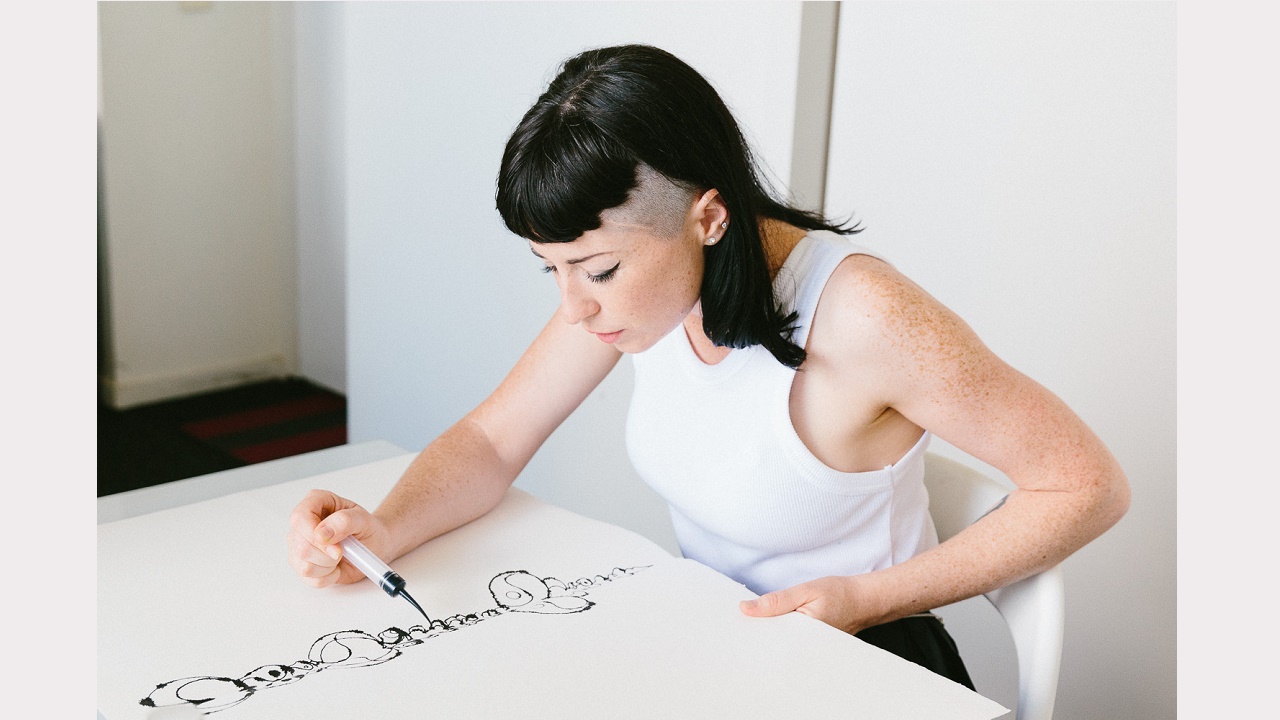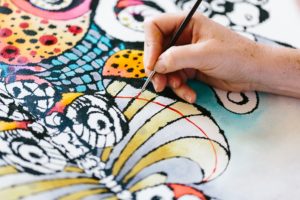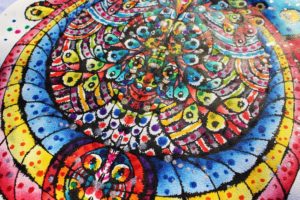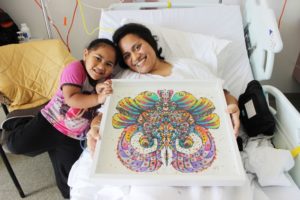Symbolic works created with ink-filled syringe capture life and offer therapy
Symbolic works created with ink-filled syringe capture life and offer therapy
by Heather Wiseman
Wednesday, August 03, 2016
The national Life in Death art competition closes at the end of next week, so it’s time to meet one of the judges. Flutter Lyon explains how her Ink-Pressings have captured the life stories of people receiving palliative care and their therapeutic effect. She also reveals her philosophy as a judge and what she will be looking for in a winning piece.
When performance artist Flutter Lyon went through the process of working out what she wanted to achieve through her work and why, her thinking distilled into two simple concepts. She wanted to have a profound and lasting effect on people, and to tap into the essence of what matters to human beings.
Such is the calibre of thinking behind Flutter’s deeply symbolic Ink-Pressings, which most recently have captured precious memories for people receiving palliative care at Liverpool Hospital in Sydney. Flutter captures patients’ memories in symbols as they respond to a series of questions in nurturing interviews, which are recorded.
Flutter teamed up with The GroundSwell Project to run the Reflected Legacy pilot program at the hospital last year. It resulted in a book, which documented highlights from the lives of 15 patients, an exhibition. The program has been ongoing, involving a further 25 patients. Flutter is developing a training program for other artists so the concept can be rolled out nationally.
At the core of Flutter’s success has been seeing the gifts that come with her mental health diagnosis.
“I live with bipolar disorder and I am determined to speak about that very openly,” she says.
“I live a life of very rich emotions and therefore have a very empathetic element to my character. I’m always very passionate about people being able to share their story openly.”
Flutter realised she felt peaceful and present when she saw her psychologist, largely because she felt seen and heard.
She says people can forget how much they matter and that they’re “stunning human beings who should be heard” because life tends to be too busy to stop, stand still, and look back at all that has occurred.
“I want to make people feel like they are seen and heard on a very deep level."
“I want to make people feel like they are seen and heard on a very deep level. I sit with someone and give them my full attention to bring them to a space of comfort, peace and understanding of their place on this planet.
“Together, we create this beautiful, striking, symmetrical image, through an experience that is highly therapeutic. It is very deep. There are usually tears. It is a release.”
Her work in palliative care starts with support from allied health professionals on the ward, who help her identify who is well enough to participate, before offering those patients a session. She visits those who accept with a trolley which carries her art equipment and some large hand-cut confetti.
Flutter says a blessing, which sets the tone for sharing stories which capture feelings and memories, before releasing her confetti to flutter around the room.
“The confetti has a profound effect on the way the room feels,” she says.
“It turns it from being a clinical hospital room to a safe, honest, trusting place. Then the room is covered in colour. It creates this beautiful space.”
Flutter starts the hour-long conversation by asking the patient to share a story about a time in their lives when they felt absolutely free. As they speak, maybe of falling in love, Flutter responds to the images that form in her mind. One man who had been married for 50 years shared that the day he got married was a day of finally feeling absolutely free.
She uses an ink-filled syringe to draw an image that creates the “backbone of the piece; the heart of the artwork”.
“The story might have motion built into it, so I might draw a bow and arrow which has travelled through time, with freedom in its essence, to represent that journey,” Flutter says.
The paper is then folded and pressed, to create a mirror image, in a process she describes as “the ancient art of mark making”.
She asks about joy. Should they speak of three children, she may use the syringe to add three symbols of love. If they speak of a significant trip, she may add a symbolic arc. Memories of when the patient became stronger in their life, of a childhood memory, or a story of courage are woven through with symbols. She asks more abstract questions too, which inspire colours she selects for the artwork: “Today if you were a flower, texture or sound – what would you be?”
“By the end, we’ve filled the whole artwork with symbols and we’ve recorded what the patient has said.”
Flutter takes the artwork to her hospital-based studio and fills it with colour as she listens to the patient’s stories again.
“One woman, Elaine, took a trip with her husband across the Nullarbor Plain so the artwork is full of beautiful, desert, sunset colours, and grey blue inspired by the dust and dusk coming.”
The artwork is then framed and presented to the patient and their family.
Flutter says that while much of her interaction with patients is intuitive, she has also spent time with neuroscientists and psychologists to develop her therapeutic skills.
Having dedicated her life to this work over a decade, she is moved to find the Ink-Pressings often have pride-of-place in people’s living rooms.
“I find it so beautiful that they put the artwork in such a significant place. I want them to celebrate their individuality. That’s which has inspired each piece and that’s why they all look different, just like everyone’s energy and spirit is different,” she says.
Hear a patient explain the impact of Flutter's work
Flutter is looking forward to judging Palliative Care Australia’s art exhibition, Life in Death, which she says gives artists the opportunity to express some of the most complex human emotions.
“It raises those heavy elements of grief, sadness, fear and death, which art can transform into strength, beauty, light and love.
“There is an alchemy about this competition and I’m excited about how people will engage with it.”
She will be looking for work that shows courage.
“All great art has great vulnerability in it,” she says.
“The artist is running a risk by being unsafe and not hiding themselves away from the world. How much courage and self-exposure have you brought into this art work and what honest, human story are you sharing by doing this?”
Flutter says she admires each artist who enters the competition.
“Each of those entries is a healing piece. I greatly honour every entry.”
Flutter says the Reflected Legacy training program will be open to artists with therapeutic capacity or therapists with artistic ability. Contact her to register your interest.
The Life in Death art competition is an initiative of Palliative Care Australia. For more information and to enter, click here.




